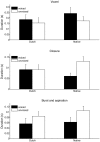Constraints on the transfer of perceptual learning in accented speech
- PMID: 23554598
- PMCID: PMC3612694
- DOI: 10.3389/fpsyg.2013.00148
Constraints on the transfer of perceptual learning in accented speech
Abstract
The perception of speech sounds can be re-tuned through a mechanism of lexically driven perceptual learning after exposure to instances of atypical speech production. This study asked whether this re-tuning is sensitive to the position of the atypical sound within the word. We investigated perceptual learning using English voiced stop consonants, which are commonly devoiced in word-final position by Dutch learners of English. After exposure to a Dutch learner's productions of devoiced stops in word-final position (but not in any other positions), British English (BE) listeners showed evidence of perceptual learning in a subsequent cross-modal priming task, where auditory primes with devoiced final stops (e.g., "seed", pronounced [si:t(h)]), facilitated recognition of visual targets with voiced final stops (e.g., SEED). In Experiment 1, this learning effect generalized to test pairs where the critical contrast was in word-initial position, e.g., auditory primes such as "town" facilitated recognition of visual targets like DOWN. Control listeners, who had not heard any stops by the speaker during exposure, showed no learning effects. The generalization to word-initial position did not occur when participants had also heard correctly voiced, word-initial stops during exposure (Experiment 2), and when the speaker was a native BE speaker who mimicked the word-final devoicing (Experiment 3). The readiness of the perceptual system to generalize a previously learned adjustment to other positions within the word thus appears to be modulated by distributional properties of the speech input, as well as by the perceived sociophonetic characteristics of the speaker. The results suggest that the transfer of pre-lexical perceptual adjustments that occur through lexically driven learning can be affected by a combination of acoustic, phonological, and sociophonetic factors.
Keywords: cross-modal priming; foreign-accented speech; perceptual learning; speech.
Figures





References
-
- Baayen R. H., Piepenbrock R., Gulikers L. (1995). The CELEX Lexical Database. Philadelphia, PA: Linguistic Data Consortium, University of Pennsylvania
LinkOut - more resources
Full Text Sources
Other Literature Sources

